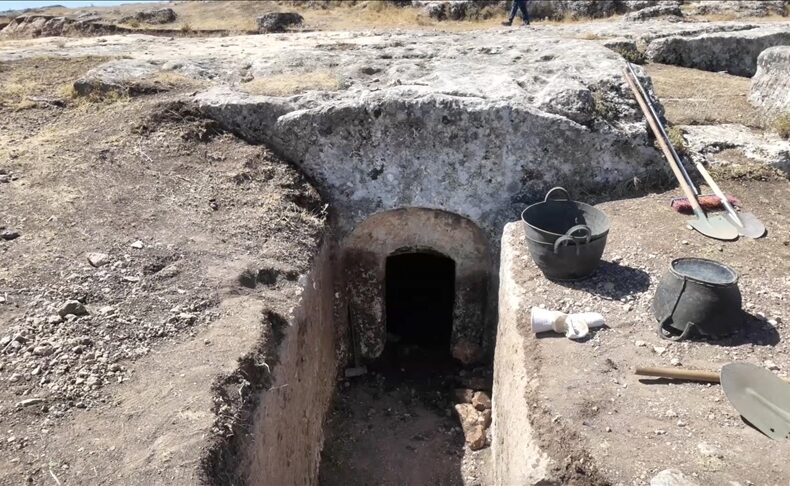
1,800-Year-Old Chamber Tomb Unearthed in the Ancient City of Tharsa, Adıyaman
Archaeologists have uncovered a remarkably well-preserved 1,800-year-old chamber tomb in the ancient city of Tharsa, located near Kuyulu Village in southeastern Türkiye. The discovery, dated to the Roman period, reveals new insights into burial traditions in the region and marks one of the most elaborate examples ever found in Tharsa.
According to Mehmet Alkan, Director of the Adıyaman Museum, the team unearthed an exceptionally detailed tomb chamber. “Inside, we found a kline scene, a female bust, and a vase. The ceiling is decorated with cross-shaped figures — a feature never seen before in Tharsa,” Alkan told reporters.

A Glimpse into Roman Funerary Art
Tharsa, situated along the Adıyaman–Şanlıurfa highway, was an important Roman-era necropolis known for its rock-cut tombs and monumental burial chambers carved into limestone hillsides. Archaeological data suggest the settlement flourished around the 2nd century CE, during a period of intense Roman urbanization across Anatolia.
The newly uncovered chamber is carved directly into the bedrock and accessed by a stairway leading downward. Inside, the walls and ceiling bear intricate reliefs and symbolic figures — notably the kline scene, a motif representing the deceased reclining at a banquet or resting, an image often reserved for the elite of Roman society.
📣 Our WhatsApp channel is now LIVE! Stay up-to-date with the latest news and updates, just click here to follow us on WhatsApp and never miss a thing!!
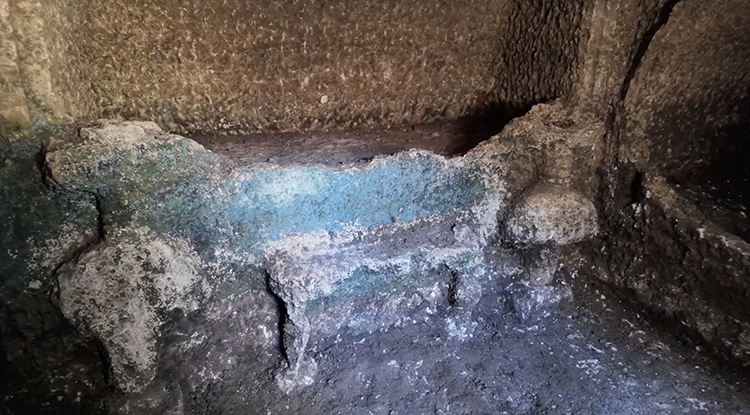
Tharsa: An Overlooked Archaeological Treasure
Excavations in Tharsa began in earnest in 2019, and since then, more than 40 chamber and rock-cut tombs have been documented. Previous discoveries revealed carved bull heads (bucrania), garland friezes, and rosette motifs, suggesting strong ritual and religious symbolism linked to funerary cults.
Scholars note that the craftsmanship of the newly found tomb surpasses that of nearby sites such as Perre Ancient City, another Roman necropolis in Adıyaman. This, they argue, positions Tharsa as a key reference site for studying regional variations in Roman burial architecture in Anatolia.
Growing Interest and Cultural Tourism
Museum Director Alkan emphasized that both domestic and international visitors have shown growing interest in Tharsa over the past few years, aided by promotional efforts led by the Adıyaman Directorate of Culture and Tourism.

Experts believe the area holds strong potential for cultural heritage tourism and could eventually be transformed into an open-air archaeological park once preservation measures are completed.
A Window into Life and Death in Roman Anatolia
The discovery provides rare insight into the funerary customs of Roman Anatolia. The presence of the kline relief, female bust, and vase indicate that the tomb likely belonged to a person of high social standing. Meanwhile, the cross-shaped motifs on the ceiling, documented for the first time in the region, point to a unique synthesis of Roman artistic influence and local symbolism.
Archaeologists say each new season at Tharsa reveals another layer of its extensive underground necropolis, suggesting that the ancient city still holds many secrets beneath its rocky terrain.
You may also like
- A 1700-year-old statue of Pan unearthed during the excavations at Polyeuktos in İstanbul
- The granary was found in the ancient city of Sebaste, founded by the first Roman emperor Augustus
- Donalar Kale Kapı Rock Tomb or Donalar Rock Tomb
- Theater emerges as works continue in ancient city of Perinthos
- Urartian King Argishti’s bronze shield revealed the name of an unknown country
- The religious center of Lycia, the ancient city of Letoon
- Who were the Luwians?
- A new study brings a fresh perspective on the Anatolian origin of the Indo-European languages
- Perhaps the oldest thermal treatment center in the world, which has been in continuous use for 2000 years -Basilica Therma Roman Bath or King’s Daughter-
- The largest synagogue of the ancient world, located in the ancient city of Sardis, is being restored



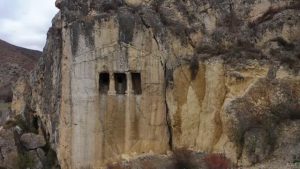

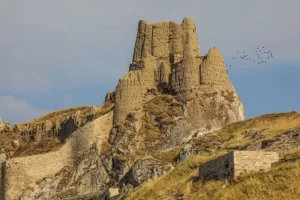
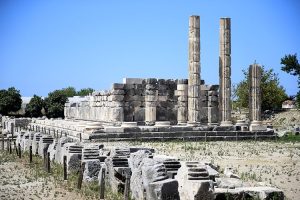



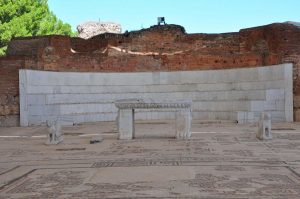
Leave a Reply